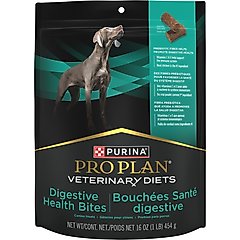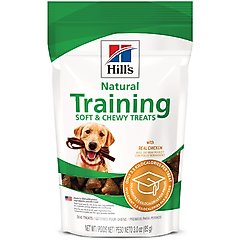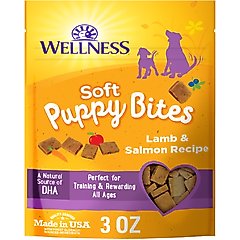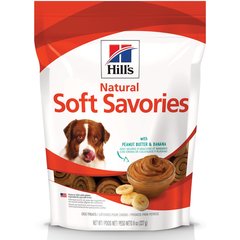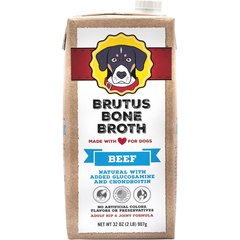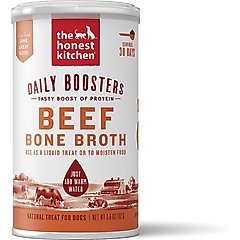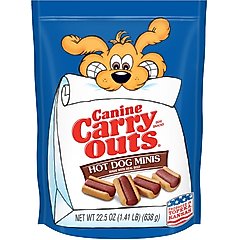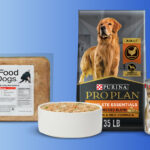Can Dogs Eat Hot Dogs?
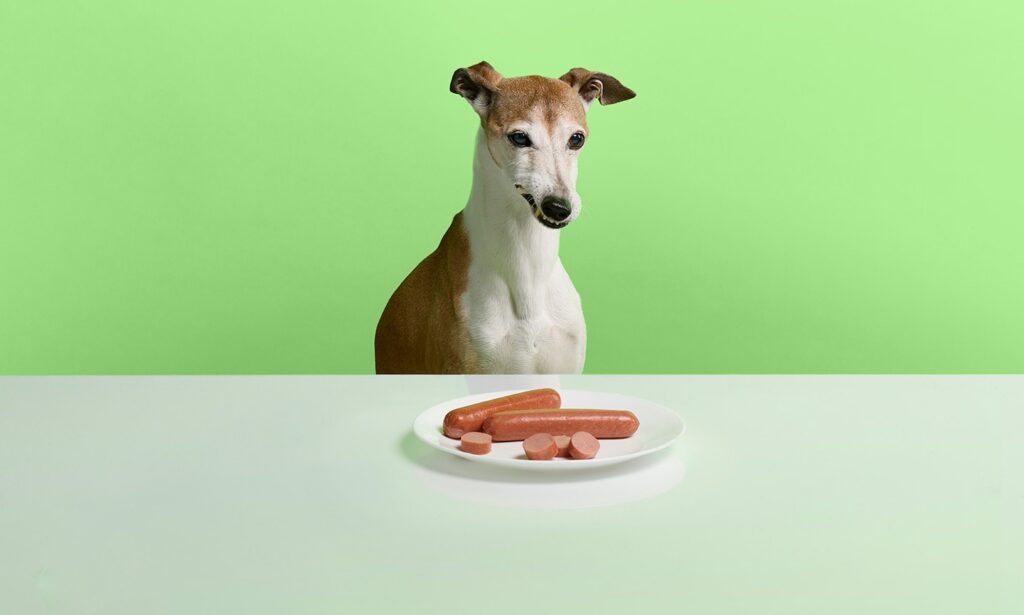
Photo by Chewy
As you’re loading up your bun with all the fixings, you catch your canine companion giving you “the look”—that pleading stare that begs for a taste of the grilled goodness. Can dogs eat hot dogs too?
Unlike other summer BBQ foods dangerous for dogs, it’s safe to give your tail-wagging pal small pieces of plain, cooked hot dog in moderation. Of course, there are some cautions and guidelines to consider.
We spoke with a vet expert to learn how to safely treat your furry friend with this all-American food.
Before introducing any new food into your dog’s diet, always check with your veterinarian.
Can Dogs Have Hot Dogs?
Yes, dogs can have hot dogs! However, it’s crucial to note that not every hot dog on the shelf is fit for Fido and that hot dogs should only be an occasional treat.
Here are some key factors to consider when selecting a hot dog that’s safe for your pup:
- Choose leaner meats, like chicken or turkey, whenever possible.
- Avoid preservatives, like nitrates, nitrites, and artificial colors.
- Look for low- or reduced-sodium options.
- Check the ingredients to make sure there’s no onion, garlic, or spicy additions, like pepper, chili, or certain types of paprika, like hot paprika.
Are Hot Dogs Good for Dogs?
While hot dogs are far from being a healthy food for humans or dogs, there are some pawsitive advantages that come with serving this snack to your four-legged friend.
- They’re high in protein. Protein is essential for muscle development, tissue repair, and overall health, and particularly beneficial for active dogs or those undergoing training.
- They offer some nutrients. Hot dogs provide some nutrients, including selenium and vitamin B12.
- They’re a high-value reward. Because they’re so tasty to most dogs, they can motivate your pup to learn and perform commands.
Are Hot Dogs Bad for Dogs?
Can I feed a dog a hot dog without causing harm? While hot dogs can be a fun treat for your canine bestie, there are a few risks to keep in mind, including:
- They can contain unhealthy additives. Many hot dogs contain sodium nitrate, which has been linked to cancer, plus monosodium glutamate (MSG), artificial sweeteners, and potentially harmful seasonings such as garlic and onion powder.
- They’re loaded with sodium. Consuming excessive amounts of sodium can lead to health complications such as dehydration and salt poisoning (hypernatremia).
- They’re high in fat. Consumption of fatty foods, like beef hot dogs, can contribute to stomach upset and more serious issues, like pancreatitis, in dogs.
- They can be a choking hazard. Due to their size and shape, hot dogs can be a choking hazard. Always serve hot dogs in bite-size pieces.
Are Hot Dogs Good Training Treats for Dogs?
Small, soft, and smelly treats are often recommended for high-value training situations, because they capture a dog’s attention and motivate them to learn. Hot dogs fall into this camp.
Because of this, you can use hot dogs as training treats, but only in moderation. Hot dogs are higher in fat, calories, and sodium than other types of training treats, so they can contribute to unhealthy weight gain and other issues if you overdo it.
Instead, alternate hot dogs with vet-recommended dog treats, like the following:
Recommended Products
How Much Hot Dog Can My Dog Eat?
While you may be tempted to spoil your dog by tossing them a whole link, portion control is essential.
Human foods and treats should make up no more than 10% of a dog’s daily calories. The other 90% should come from a vet-recommended dog food.
Recommended Products
The average hot dog provides about 150 calories, and the amount of hot dog you can give your dog depends on their size. It’s also best to limit giving your pup this treat to one to two times per week.
Let’s break it down:
| Dog Size | Serving Size | Frequency |
|---|---|---|
| Extra-small dogs (2–10 pounds) | 1 piece (1/4-inch thick) | 1–2 times per week |
| Small dogs (11–20 pounds) | 1–2 pieces (1/4-inch thick) | 1–2 times per week |
| Medium dogs (21–50 pounds) | 2–3 pieces (1/4-inch thick) | 1–2 times per week |
| Large dogs (51–90 pounds) | 4–5 pieces (1/4-inch thick) | 1–2 times per week |
| Extra-large dogs (91+ pounds) | Up to half of a hot dog, cut into 1/4-inch-thick pieces | 1–2 times per week |
How To Safely Feed Hot Dogs to Your Dogs
Serving size is important, but there are some other things you’ll also want to consider to safely feed hot dogs to your pup:
- Choose a natural hot dog. Look for natural ingredients and as few additives as possible.
- Cook it. Hot dogs are technically pre-cooked, so they’re not raw in the same sense as raw ground beef or raw chicken. However, they can still harbor bacteria and other pathogens that may pose a risk to your dog’s health. For safety, cook the hot dog before serving it to your pup.
- Slice it. Cut the hot dog into bite-size pieces (about 1/4-inch thick) to limit portion sizes and minimize the risk of choking.
- Serve it plain. Don’t add salt, other seasonings, or condiments to the hot dog.
And while your dog would undoubtedly wolf down a hot dog in any shape or form, adding a dash of creativity to how you serve this treat can make the experience more exciting for both of you. Here are some ideas:
- Stuff in a filler toy. An interactive food-dispensing toy, like a KONG, is a fantastic way to keep your dog entertained and reward them with treats. Stuff a KONG with a few small pieces of cooked hot dog—just make sure to clean it thoroughly afterward.
Recommended Product
- Make a hot dog “gravy.” Simply pour 1 cup of dog-friendly broth into a blender, add one cooked hot dog, and blend. Pour 1–4 tablespoons of the “gravy” (depending on your pup’s size) over your dog’s regular kibble as an occasional treat.
Recommended Products
- Offer a store-bought hot dog treat. If you want to let your dog in on the hot dog fun without the fuss of cooking, consider ready-to-serve hot dog treats—our favorites are below.
Homemade Hot Dog Treats
For an extra-special snack, serve up this homemade hot-dog inspired dog treat. Made with beef sticks, a peanut butter-infused bun, and topped with a cheesy spread, it’s dog-approved.
Store-Bought Dog Treats with Hot Dogs
Instead of making dog treats with hot dogs, you can just buy them! Here are some pet parent-approved options:
Recommended Products
My Dog Ate Too Much Hot Dog—What Do I Do?
Too many hot dogs can give your dog an upset stomach or pancreatitis, which can be serious. If your dog overdoes it, keep a close eye on them for the next day or so to see if they start showing any of these signs:
- Vomiting
- Diarrhea
- Lethargy
- Stomach pain
- Excessive thirst
- Excessive drooling
- Pacing or restlessness
If symptoms are severe or last for more than 24 hours, call your vet. They may suggest bringing your dog in for an exam or continuing to monitor at home.
FAQs About Hot Dogs for Dogs
Q: Can puppies eat hot dogs?
A: It’s better not to give your puppy a hot dog. Puppies have more sensitive stomachs, and hot dogs can cause digestive upset.
Q: Can dogs eat raw hot dogs? Can I use raw hot dog pieces as training treats?
A: Most commercially available hot dogs are pre-cooked, so they’re not raw like other meats. That said, you should still heat them up to reduce harmful pathogens before serving as a treat.
Q: What should I do if my dog eats a raw hot dog?
A: Monitor your dog for signs of stomach upset, like vomiting and diarrhea. If symptoms are severe or last more than 24 hours, call your vet.
Q: Are there any brands of hot dogs that are safer for pets?
A: There aren’t specific brands of hot dogs that are safer for pets. Look for options that are uncured (nitrite and nitrate-free) and made without unnecessary fillers.
Attributions
This content was medically reviewed by a veterinarian.
